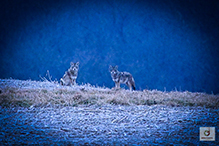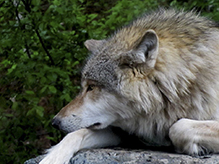Gray wolf
(Canis lupus)
Conservation • Description • Habitat • Biology • Distribution • Taxonomy
Description |
||
Eastern wolf (C. l. lycaon), also called timber wolf, is relatively small, with males weighing on average 67 pounds and females 53 pounds. They have longer ears and a narrower snout. They tend to be mottled gray. Great Plains wolf (C. l. nubilus) is much larger, with males weighing on average 100 pounds. They have shorter ears and a broader snout. They can vary from black to white, though most are gray. Great Lakes boreal wolf (C. l. lycaon x C. l. nubilus) mostly has intermediate traits, grading from more C. l. lycaon-like in the east to more C. l. nubilus-like in the west. |
||
Size |
||
Total length: 59″ to 62″ Tail: 15½″ to 18″ |
||
Sign |
||
|
||
Similar Species |
||
Habitat |
||
Any type of habitat |
||
Biology |
||
Behavior |
||
|
||
Lifespan |
||
Usually 6 to 8 years |
||
Life Cycle |
||
|
||
Food |
||
Mostly white-tailed deer, but also beaver, other mammals, and wild fruits. |
||
Distribution |
||||
|
Sources Biodiversity occurrence data published by: Minnesota Biodiversity Atlas (accessed through the Minnesota Biodiversity Atlas Portal, bellatlas.umn.edu, 8/7/2023). Minnesota DNR; The Nature Conservancy; U.S. Fish & Wildlife Service; Distribution and Abundance of Wolves in Minnesota, 2012-13, John Erb and Barry Sampson, Minnesota Department of Natural Resources Minnesota DNR; The Nature Conservancy; U.S. Fish & Wildlife Service; Distribution and Abundance of Wolves in Minnesota, 2017-18, John Erb, Carolin Humpal, and Barry Sampson, Minnesota Department of Natural Resources |
|||
| 8/7/2023 | ||||
Occurrence |
||||
Locally common |
||||
Taxonomy |
|||
| Class | Mammalia (mammals) | ||
| Subclass | Theria | ||
| Infraclass | Placentalia (placental mammals) | ||
| Magnorder | Boreoeutheria | ||
| Superorder | Laurasiatheria (ungulates, carnivorans, and allies) | ||
| Order | Carnivora (carnivorans) | ||
| Suborder | Caniformia (dog-like carnivores) | ||
Family |
Canidae (canids) | ||
Subfamily |
Caninae |
||
| Tribe | Canini | ||
Genus |
Canis (wolves and dogs) | ||
Subordinate Taxa |
|||
Debate continues about whether there are different species of gray wolves in the world. In 2000, Wilson et al proposed designating the eastern wolf as a separate species, Canis lycaon. This proposal was not widely adopted. Eastern wolf (C. l. lycaon), also called timber wolf, was originally found in the northeastern corner of the state. Great Plains wolf (C. l. nubilus) was originally found in the western counties, with hybrids occurring between the two. The dispersal ranges of the two subspecies overlap considerably and much hybridization occurs. The original genetic purity of the eastern and western population remains unknown. While is likely that genetically pure populations occur at the ends of the respective Minnesota ranges, the current Minnesota population consists mostly of hybrids of the two subspecies, known informally as Great Lakes boreal wolf, with more C. l. nubilus traits in the west and more C. l. lycaon traits in the east. |
|||
Alaskan tundra wolf (Canis lupus tundrarum) Alexander Archipelago wolf (Canis lupus ligoni) Arabian wolf (Canis lupus arabs) Arctic wolf (Canis lupus arctos) Baffin Island wolf (Canis lupus manningi) Bernard’s wolf (Canis lupus bernardi) British Columbia wolf (Canis lupus columbianus) Cascade Mountain wolf (Canis lupus fuscus) dingo (Canis lupus dingo) domestic dog (Canis lupus familiaris) eastern wolf (Canis lupus lycaon) Eurasian wolf (Canis lupus lupus) Florida black wolf (Canis lupus floridanus) Gansu wolf (Canis lupus filchneri) Great Lakes boreal wolf (Canis lupus lycaon x Canis lupus nubilus) Great Plains wolf (Canis lupus nubilus) Greenland wolf (Canis lupus orion) Gregory’s wolf (Canis lupus gregoryi) Hokkaidō wolf (Canis lupus hattai) Honshū wolf (Canis lupus hodophilax) Hudson Bay wolf (Canis lupus hudsonicus) Indian wolf (Canis lupus pallipes) Kenai Peninsula wolf (Canis lupus alces) Labrador wolf (Canis lupus labradorius) Mackenzie River wolf (Canis lupus mackenzii) Manitoba wolf (Canis lupus griseoalbus) Mexican wolf (Canis lupus baileyi) Mogollon Mountain wolf (Canis lupus mogollonensis) Newfoundland wolf (Canis lupus beothucus) Northern Rocky Mountains wolf (Canis lupus irremotus) Northwestern wolf (Canis lupus occidentalis) Red wolf (Canis lupus rufus) Southern Rocky Mountains wolf (Canis lupus youngi) Steppe wolf (Canis lupus campestris) Texas wolf (Canis lupus monstrabilis) Tibetan woolly wolf (Canis lupus chanco) tundra wolf (Canis lupus albus) Vancouver Island wolf (Canis lupus crassodon) Yukon wolf (Canis lupus pambasileus) |
|||
Synonyms |
|||
|
|||
Common Names |
|||
gray wolf wolf |
|||
Visitor Photos |
|||||
Share your photo of this mammal. |
|||||
| This button not working for you? Simply email us at info@MinnesotaSeasons.com. Attach one or more photos and, if you like, a caption. |
|||||
Mike Poeppe |
|||||
Coyote/wolf I found this pair about 6 miles south of Houston on Thursday morning. I am not sure if they are wolves or coyote? They were out about 1/2 mile and sure looked big for out that far. |
 |
||||
Kim |
|||||
walking down country road like it owned it. Never stopped never looked around just kept going this was at 645 am |
 |
||||
Ramona Abrego |
|||||
Captive – Wildlife Science Center |
|||||
 |
 |
||||
 |
 |
||||
 |
 |
||||
 |
 |
||||
 |
 |
||||
 |
 |
||||
 |
|||||
MinnesotaSeasons.com Photos |
|||||
|
|||||

Slideshows |
||
| Gray Wolf Craig A. Mullenbach |
||

|
||
About
This is a Gray Wolf named Sheriff from the Minnesota Wildlife Connection. He was brought in to be photographed at the Spring Break event held by the Twin Cities Area Counsel of Camera Clubs. |
||

Visitor Videos |
|||
Share your video of this mammal. |
|||
| This button not working for you? Simply email us at info@MinnesotaSeasons.com. Attach a video, a YouTube link, or a cloud storage link. |
|||
Other Videos |
|||
| The Wolves Krecika1988 |
|||
About
Uploaded on Mar 12, 2007 The Gray Wolf (Canis lupus; also spelled Grey Wolf, see spelling differences; also known as Timber Wolf or Wolf) is a mammal in the order Carnivora. The Gray Wolf shares a common ancestry with the domestic dog (Canis lupus familiaris), as evidenced by DNA sequencing and genetic drift studies. Gray wolves were once abundant and distributed over much of North America, Eurasia, and the Middle East. Today, for a variety of human-related reasons, including widespread habitat destruction and excessive hunting, wolves inhabit only a very limited portion of their former range. Though listed as a species of least concern for extinction worldwide, for some regions including the Continental United States, the species is listed as endangered or threatened. IF U LOVE WOLVES PLZ ENJOY IT!! SAVE THEM!! |
|||
| Timberwolf (Canis lupus lycaon) [HQ] Kanal von AnimalPlanetH |
|||
About
Uploaded on Jun 10, 2010 Timberwölfe beim Fressen (Zoo Hannover) |
|||
| Wolves, Ely Minnesota 2008 marinacastillo |
|||
About
Uploaded on Dec 27, 2008 Wolves, Ely Minnesota 2008 |
|||

Visitor Sightings |
|||||
Report a sighting of this mammal. |
|||||
| This button not working for you? Simply email us at info@MinnesotaSeasons.com. Be sure to include a location. |
|||||
| Mike Poeppe 12/22/2023 |
Location: 6 miles south of Houston, MN I found this pair about 6 miles south of Houston on Thursday morning. I am not sure if they are wolves or coyote? They were out about 1/2 mile and sure looked big for out that far. |
||||
| Kim 8/7/2023 |
Location: Faribault, MN walking down country road like it owned it. Never stopped never looked around just kept going this was at 6:45 am |
 |
|||
| Ramona Abrego | Location: Wildlife Science Center Captive |
||||
MinnesotaSeasons.com Sightings |
|||||
Nemadji State Forest |
|||||

Last Updated:



